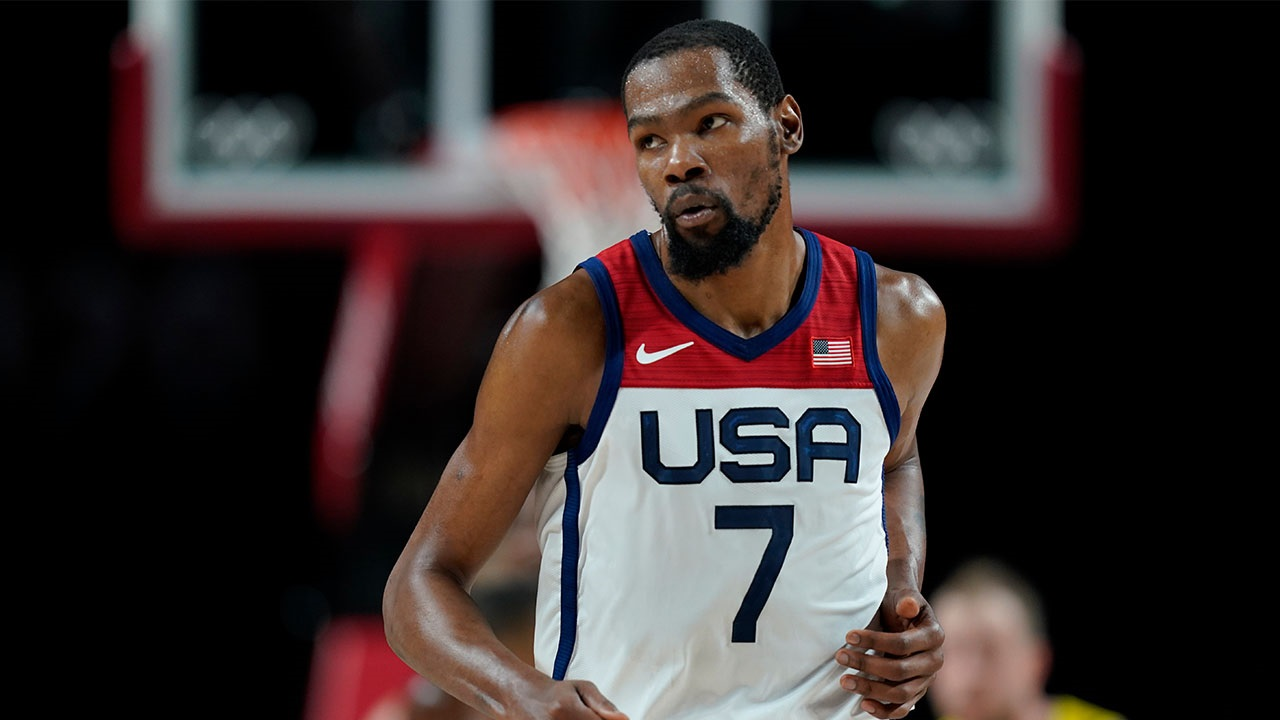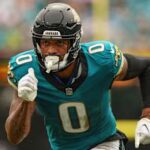The National Basketball Association (NBA) world was unexpectedly set ablaze with a monumental trade, occurring just hours before a pivotal Game 7 in the 2025 Finals.
In a shocking move, future Hall of Famer Kevin Durant was sent from the Phoenix Suns to the Houston Rockets. This blockbuster deal fundamentally alters the landscape of both franchises and sends ripples across the league. The trade package involved the Rockets acquiring Durant in exchange for two key players, Jalen Green and Dillon Brooks, along with significant draft capital: the No. 10 overall pick in the upcoming Wednesday’s draft and five additional second-round selections.
This kind of high-stakes transaction, especially involving a player of Durant’s caliber who will turn 37 around the start of training camp, rarely happens on such a significant day for the league. As the Oklahoma City Thunder and Indiana Pacers prepared to battle for the 2025 championship, the news of Durant’s move dominated headlines, sparking immediate questions.
Which team emerged victorious from this trade? How will a seasoned superstar like Durant integrate into the Rockets’ predominantly young roster? And what does this imply for the Phoenix Suns, who seemingly are embarking on a full rebuild after a failed superteam experiment? ESPN NBA insider Kevin Pelton provided a comprehensive analysis, grading the deal from every perspective and offering deep insights into its potential ramifications.
The Rockets’ Perspective: Targeting Contention
Houston’s acquisition of Kevin Durant signals their clear intent to transition from a developing young team to a legitimate contender in the Western Conference.
Addressing Half-Court Offense Deficiencies
The Houston Rockets, despite their rapid ascent to becoming the second seed in the Western Conference last season, faced a glaring weakness that became particularly evident during their playoff run. Their seven-game series loss to the veteran-laden Golden State Warriors in the opening round starkly “exposed the Rockets’ need for more half-court scoring punch.”
During the regular season, Houston often compensated for this by excelling in transition offense and dominating the offensive glass, generating numerous second-chance points. According to Cleaning the Glass, no team averaged more points per missed shot on second chances, highlighting their reliance on these opportunistic scores.
However, as the playoffs progressed, especially in tightly contested games, these advantages tended to diminish. In “clutch” situations against the Warriors – defined as games with a margin inside five points in the last five minutes – the Rockets struggled immensely, going 0-3 and posting an “ugly 91 offensive rating” per NBA Advanced Stats. This points to a significant struggle in executing plays and generating efficient offense when games slowed down and defenses tightened.
With Durant, the Rockets aim to resolve this critical issue. Even at 37, Durant remains an elite self-creator. Last season, among players with a usage rate of 28% or higher, only Denver’s three-time MVP Nikola Jokic surpassed Durant’s remarkable .642 True Shooting Percentage (TS%), a measure of shooting efficiency that accounts for field goals, three-pointers, and free throws. This statistical prowess indicates that Durant is precisely the high-efficiency, half-court scorer Houston desperately needed to elevate its offense, especially in late-game scenarios.
The Fit with Houston’s Young Core
The decision to acquire Kevin Durant for the Houston Rockets was a strategic one, aimed at complementing their burgeoning young talent without sacrificing their most prized assets. The Rockets finished second in the West, with only one starter, guard Fred VanVleet, being older than 28. This youthful foundation positioned them uniquely to “thread the needle of surrounding Durant with enough talent to contend for a championship.”
Critically, the price for Durant reportedly dropped to a point where Houston “didn’t have to include any of their most prized young players in return,” such as center Alperen Sengun or wing Amen Thompson.
The contrast between Durant’s scoring efficiency and that of Jalen Green, whom he effectively replaces as a primary scorer, is stark. Green, also a former No. 2 pick, had Houston’s highest usage rate last season but with a below-average .544 TS%. While Alperen Sengun, with the team’s second-highest usage, had a similar .545 TS%, his ability to make plays for others and historical efficiency differ from Green’s. Green’s struggles were particularly evident in the playoffs, averaging just 13.3 points on 37% shooting against the Warriors. This performance encapsulated concerns about his consistency as a leading scorer.
Durant’s addition is expected to provide the consistent, high-efficiency scoring that Green could not consistently deliver, especially in crucial moments. His ability to create his own shot will alleviate pressure on the younger players and provide a reliable offensive anchor. This strategic fit aims to elevate the Rockets’ ceiling, allowing their young stars to develop in a more structured and less pressure-filled offensive environment, while Durant carries the scoring load.
Impact on Team Structure and Rotation
The departure of Dillon Brooks, while a significant short-term loss for the Rockets, is expected to be mitigated by the growth of key young defensive talents. Brooks’ arrival was instrumental in Houston’s rapid transformation from a 60-plus loss team to a 52-win playoff contender, particularly in shaping their defensive culture alongside Fred VanVleet and coach Ime Udoka. His departure does create a slight thinning of perimeter depth.
However, Amen Thompson is poised to step into an even larger role. Thompson, who received a Defensive Player of the Year vote, already surpassed Brooks as Houston’s primary perimeter stopper last season. His ability to guard multiple positions at 6-foot-7 makes him versatile. The trade of two wings (Green and Brooks) for the 6-foot-11 Durant essentially shifts Thompson from power forward to shooting guard in the Rockets’ defensive scheme without disrupting the offensive flow.
The adjustment will involve coach Udoka determining a fifth starter alongside Durant, Sengun, Thompson, and VanVleet. Jabari Smith Jr. could return to the starting five, creating a formidable frontcourt of 6-foot-11 players. Alternatively, Tari Eason, the Rockets’ sixth man, could provide a more like-for-like replacement for Brooks. These potential lineup adjustments put more pressure on recent first-round picks Reed Sheppard (No. 3 overall pick last year) and Cam Whitmore to contribute more significantly.
Both are considered capable, with Sheppard being a highly-rated prospect and Whitmore showing productivity when given opportunities. This depth ensures the Rockets maintain a strong rotation despite the trade.
Financial Implications and Future Flexibility
The acquisition of Kevin Durant, especially with a potential extension, will necessitate careful financial planning for the Rockets in the coming years.
Navigating the Luxury Tax and Extensions
The acquisition of Kevin Durant carries significant financial implications for the Houston Rockets, particularly concerning the luxury tax and future contract extensions for their young core. With the recent three-year, $39 million extension for center Steven Adams, the Rockets are already nearing the luxury tax threshold for the current season.
If they fill out their remaining roster spots with players on minimum contracts, they are approximately “$33 million below the projected luxury-tax line” before addressing Fred VanVleet’s contract situation. Houston holds a “$44.9 million team option” for VanVleet, which they could decline in favor of a new, long-term deal that pays him less in the 2025-26 season, providing immediate cap relief.
While paying a small amount of luxury tax this season would have minimal immediate impact, avoiding the “repeater tax” in future years is crucial. The repeater tax is an escalating penalty for teams that are repeat luxury tax payers, and it can have “huge ramifications down the road.” The Rockets’ financial commitments will escalate significantly once Amen Thompson’s rookie contract expires in 2027, as he is likely penciled in for a max deal.
Furthermore, Tari Eason and Jabari Smith Jr. are currently eligible for rookie extensions, adding to the impending financial decisions. Compounding this, Durant’s salary could increase with a potential extension as he heads into his late 30s. These complex financial dynamics require precise management to maintain a competitive roster while avoiding crippling luxury tax penalties in the coming years.
Retaining Valuable Draft Assets
Despite making a blockbuster trade for a superstar, one of the most impressive aspects of the Rockets’ deal for Kevin Durant is their ability to retain significant future draft capital. This positions them for continued flexibility and potential roster upgrades down the line. The Rockets successfully “retained Phoenix’s unprotected 2027 first-round pick,” which is a valuable asset given the uncertainty of the Suns’ future. This pick could be a lottery selection, offering Houston another high-value asset.
Beyond 2027, the Rockets also secured “the opportunity to get the two best of picks from the Suns, Brooklyn Nets, and Dallas Mavericks in 2029.” This gives them multiple bites at the apple in a potentially strong draft, allowing them to benefit from other teams’ struggles. Furthermore, Houston holds a “swap with the Nets in 2027,” which puts added pressure on Brooklyn’s rebuild to accelerate.
If Brooklyn struggles, Houston can swap their less favorable pick for Brooklyn’s, potentially moving up in the draft. These retained and acquired draft assets mean that Houston has not “emptied the cupboard” for Durant. They have moved into the next phase of their roster build with both immediate star power and long-term flexibility, showcasing impressive foresight from their front office.
The Suns’ Strategic Reset
For the Phoenix Suns, the Kevin Durant trade represents a pragmatic yet painful pivot, acknowledging a failed superteam experiment and charting a new course.
Admitting the Durant Experiment Failed
The Kevin Durant era in Phoenix ultimately proved to be a significant “failure for the Suns.” Despite assembling a roster with Durant, Devin Booker, and Bradley Beal, the team managed to win “only a single playoff series during his three seasons on the roster.” This underwhelming outcome, especially considering the immense assets sacrificed to acquire Durant from the Brooklyn Nets at the 2023 trade deadline (including Mikal Bridges, Cam Johnson, and four future first-round picks), necessitated a re-evaluation. The Suns are still burdened by the “2027 and 2029 first-round picks” they owe from that previous trade, making their current situation even more challenging.
Phoenix’s leverage in these trade negotiations was significantly diminished. Durant is now more than two years older, and with only one year remaining before becoming a free agent, the Suns had far less control over his destination. Their relationship with Durant also reportedly “frayed when the Suns discussed trading him in February,” making his return to Phoenix an unrealistic option.
The worst-case scenario for the Suns would have been to trade Durant for other veterans in a misguided attempt to “win now” with Booker and Beal. However, their pragmatic approach indicates a shift. While not ideal, acquiring the “No. 10 pick in the 2025 draft” (which was originally their own pick, now returned) and the 23-year-old Jalen Green represents a significant step towards rebuilding, providing both a potential young talent and valuable draft capital for the future.
Roster Imbalance and Future Moves
The trade of Kevin Durant has highlighted a significant “imbalance” on the Phoenix Suns’ roster, particularly in their guard and wing positions. With the acquisition of Jalen Green and Dillon Brooks, the Suns now possess a roster where “their five highest-paid players (Bradley Beal, Devin Booker, Green, Brooks, and Grayson Allen) could all be called natural shooting guards.” This concentration of talent at a single position creates redundancy and potential issues with defensive matchups and offensive flow.
This roster configuration strongly suggests that the “Durant trade is surely the beginning of a roster makeover rather than the completion of it.” The Suns will need to make further moves to achieve a more balanced lineup. While Jalen Green’s recent three-year, $106 million extension with the Rockets (which now transfers to the Suns) pays him like an above-average starter, his inconsistent performance in Houston suggests he might not immediately fill that role.
However, playing alongside a highly talented creator like Devin Booker could unlock Green’s upside, allowing him to thrive as a “second-side guy” who gets opportunities after defenses are focused on Booker. Dillon Brooks, on the other hand, immediately becomes “the Suns’ best perimeter defender.” This addresses a significant need for Phoenix, which often struggled defensively.
However, his future with the team is uncertain if the Suns aim to “cut payroll to avoid exceeding the second apron” of the luxury tax, which carries severe penalties including a frozen first-round pick from trades. Given his value around the league, Brooks could be a likely candidate for a future trade. The Suns’ immediate challenge is to manage this roster imbalance and make subsequent strategic moves to optimize their roster around Devin Booker and Bradley Beal, or potentially pivot further into a rebuild.
Reclaiming Draft Capital and Long-Term Outlook
A crucial component of the Kevin Durant trade for the Phoenix Suns is the return of much-needed draft capital, which had been severely depleted in their pursuit of a championship. The acquisition of the “No. 10 overall pick in Wednesday’s draft” is particularly significant. This pick was originally theirs, but it was conveyed to the Brooklyn Nets as part of the initial Durant trade in 2023.
Getting it back means they did not entirely lose out on a top-10 selection from that costly transaction. The Suns haven’t picked this high in the draft since 2020, when they selected Jalen Smith, two picks ahead of future All-Star Tyrese Haliburton.
This pick, along with the five second-rounders acquired, provides the Suns with valuable assets for the future. With only one first-round pick on a rookie contract (Ryan Dunn) currently on their roster, this influx of draft capital is vital for rebuilding their talent pipeline. While the acquisition of Durant ultimately fell short of expectations, resulting in only one playoff series win during his tenure, the Suns were in a difficult negotiating position due to their past moves.
They could not recoup the value they initially gave up for Durant, and the strained relationship with him further limited their options. However, by acquiring a top-10 pick and a young, high-upside player in Jalen Green, the Suns are attempting to “incrementally brighten a gloomy future outlook” and make better decisions moving forward, focusing on long-term sustainability rather than continued short-term gambles.
Seismic Shift in the NBA Landscape
The Kevin Durant trade to the Houston Rockets is a truly seismic event in the NBA, altering the trajectories of both franchises involved. For the Rockets, it signals a bold commitment to immediate contention, addressing their critical need for half-court scoring efficiency and providing a seasoned superstar to elevate their young core. Despite the loss of a key defensive anchor in Dillon Brooks and the financially complex road ahead, Houston’s ability to retain valuable future draft capital makes this a shrewd move, positioning them for sustained competitiveness.
Conversely, for the Phoenix Suns, this trade represents a pragmatic, albeit painful, acknowledgment of their failed superteam experiment. By shedding Durant’s contract and acquiring a top-10 draft pick along with Jalen Green and Dillon Brooks, the Suns are attempting to reset their roster and reclaim vital assets for a long-term rebuild.
While the path ahead for Phoenix remains challenging due to past asset expenditures and current roster imbalances, this trade provides them with a foundation for future flexibility. Ultimately, this blockbuster deal reshapes the Western Conference, with Houston now poised for a deeper playoff run and Phoenix embarking on a necessary, if challenging, path toward retooling their roster for sustained success. The full impact of this trade will unfold in the seasons to come.








